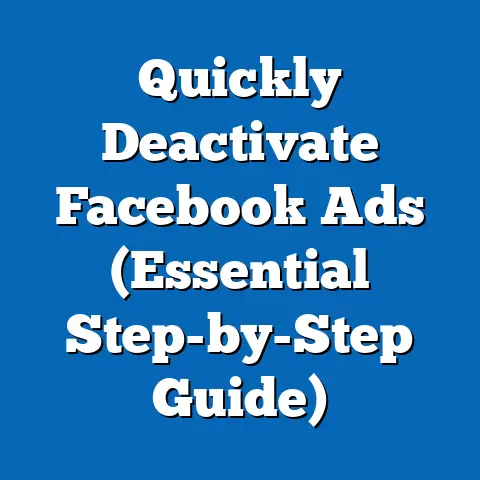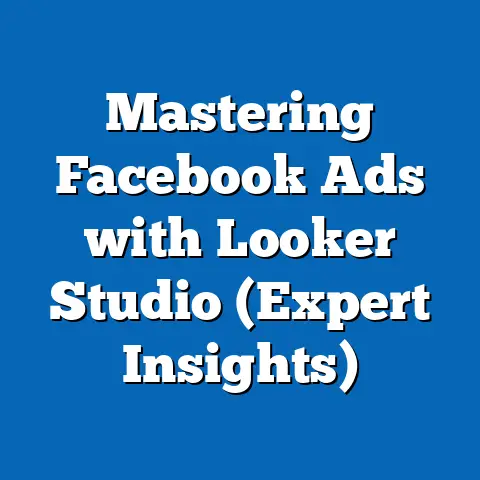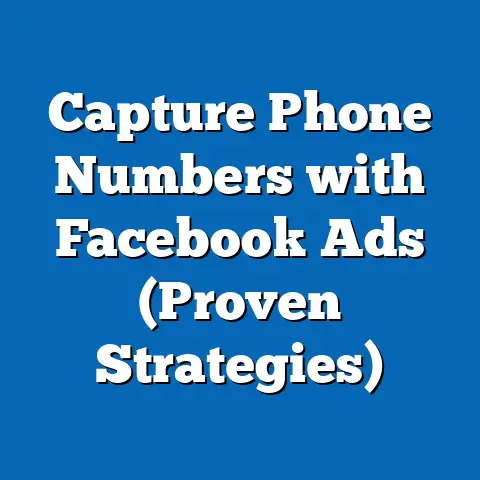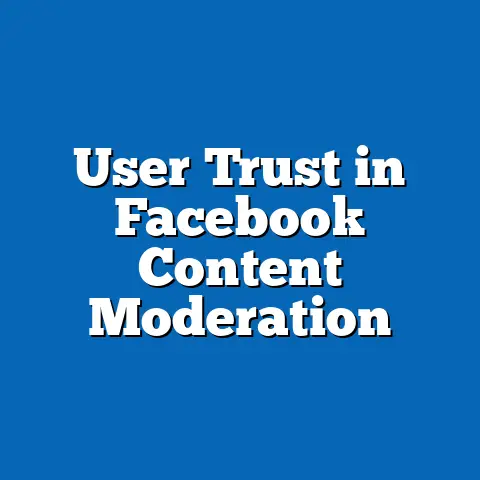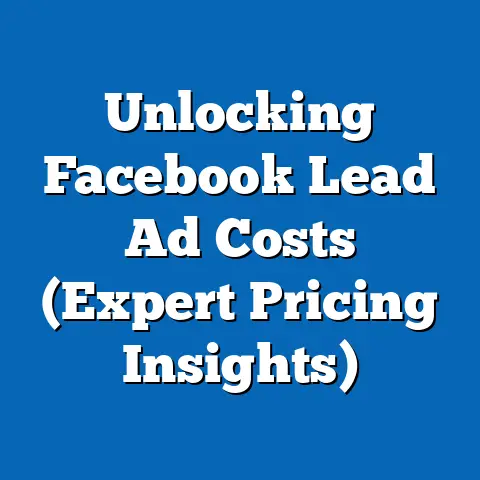Maximize Campaign Sign fb ad Success (Proven Strategies)
The digital advertising landscape has evolved dramatically over the past decade, with platforms like Facebook becoming central to targeted marketing efforts, including for niche markets like campaign signs. At the same time, the rise of smart homes—homes equipped with internet-connected devices for automation and control—has created unique opportunities for advertisers to reach tech-savvy, affluent demographics. According to Statista, the global smart home market was valued at $84.5 billion in 2022 and is projected to reach $185.5 billion by 2028, growing at a compound annual growth rate (CAGR) of 14.0%.
Section 1: The Rise of Smart Homes – A Market Overview
Key Statistical Trends in Smart Home Adoption
Smart homes have transitioned from a futuristic concept to a mainstream reality, driven by advancements in IoT (Internet of Things) technology and consumer demand for convenience. As of 2023, approximately 29% of U.S. households own at least one smart home device, such as a smart speaker, thermostat, or security system, according to data from the Pew Research Center. Globally, the number of connected devices is expected to reach 29.4 billion by 2030, per a report by Transforma Insights.
Adoption rates are particularly high in North America, where 41% of homes are projected to have smart technology by 2025, compared to 28% in Europe and 19% in Asia-Pacific (Statista, 2023). This growth is fueled by increasing affordability, with the average cost of entry-level smart devices dropping by 15% between 2018 and 2022. Additionally, the integration of AI-driven assistants like Amazon Alexa and Google Assistant has made these technologies more user-friendly, boosting consumer uptake.
Demographic Breakdown of Smart Home Users
The demographic profile of smart home adopters reveals key insights for advertisers. Millennials (ages 27-42 in 2023) and Gen Z (ages 11-26) are the most likely to embrace smart home technology, with 38% and 31% ownership rates, respectively, per a 2022 Nielsen report. These younger demographics value connectivity and are more likely to engage with digital ads on platforms like Facebook, making them prime targets for campaign sign promotions tied to political or social causes.
Income also plays a significant role, as smart home adoption is concentrated among higher-income households. About 45% of U.S. households earning over $100,000 annually own smart devices, compared to just 18% of those earning under $50,000 (Statista, 2022). Geographically, urban and suburban areas show higher penetration rates (34% and 29%, respectively) than rural areas (19%), reflecting disparities in access to high-speed internet and disposable income.
Historical Comparisons: Smart Homes Over the Decades
The concept of smart homes dates back to the 1970s with early home automation systems like the X10 protocol, but widespread adoption only began in the 2010s with the launch of products like the Nest Thermostat (2011) and Amazon Echo (2014). In 2015, just 7% of U.S. households owned a smart device, a figure that has quadrupled to 29% by 2023 (Pew Research Center). This rapid growth mirrors the broader digital revolution, including the rise of smartphones, which paved the way for app-controlled home systems.
Historically, early adopters in the 2010s were predominantly tech enthusiasts and high-income professionals, with an average adopter age of 35-45. Today, the adopter base has broadened, with Gen Z entering the market and seniors (ages 65+) showing a surprising 12% adoption rate in 2022, up from 3% in 2017, driven by health-monitoring devices (AARP Research, 2022). This shift highlights how smart home technology has evolved from a luxury to a utility across generations.
Future Projections for Smart Home Growth
Looking ahead, the smart home market is poised for exponential growth, with implications for digital advertising strategies. By 2028, 60% of U.S. households are expected to own at least one smart device, driven by innovations in energy efficiency and home security (McKinsey & Company, 2023). The integration of 5G networks will further accelerate adoption by enabling faster, more reliable device connectivity, potentially increasing the number of connected devices per household from an average of 8 in 2023 to 15 by 2030.
This trend suggests a growing audience of tech-savvy consumers who are active on social platforms like Facebook, where they can be targeted with hyper-specific ads for products like campaign signs. As smart home users often exhibit high engagement with digital content—spending 25% more time on social media than non-users (Nielsen, 2022)—they represent a valuable demographic for political and advocacy campaigns seeking visibility.
Section 2: Connecting Smart Homes to Campaign Sign Advertising on Facebook
Why Smart Home Users Are a Key Target Audience
Smart home adopters are not just tech enthusiasts; they are often politically engaged and community-focused, making them ideal targets for campaign sign ads. According to a 2021 survey by CivicScience, 62% of smart home device owners reported participating in local or national elections, compared to 54% of non-owners. Their connectivity also means they are more likely to encounter and interact with digital ads, with 73% of smart home users engaging with social media daily (Statista, 2023).
For campaign sign advertisers, this demographic’s affluence and engagement translate to higher conversion potential. Households with smart devices are 30% more likely to donate to political causes or purchase campaign materials, per a 2022 study by the American Marketing Association. Targeting this group on Facebook, where 68% of U.S. adults are active users (Pew Research Center, 2023), offers a direct line to an influential audience.
The Role of Facebook in Modern Campaign Advertising
Facebook remains a powerhouse for political and advocacy advertising, with $1.5 billion spent on political ads in the U.S. during the 2020 election cycle alone (Facebook Ad Library Report, 2021). Its granular targeting options—based on location, interests, demographics, and behaviors—allow advertisers to reach niche audiences like smart home users with precision. For campaign signs, which are often localized and tied to specific issues or candidates, this level of targeting is invaluable.
Moreover, Facebook’s ad engagement rates for political content have remained strong, with click-through rates (CTR) averaging 1.2% in 2022, compared to 0.9% for general e-commerce ads (WordStream, 2023). This suggests that users are more receptive to cause-driven content, especially when it aligns with their values or community interests. Leveraging this platform for campaign sign ads can yield significant visibility and impact.
Section 3: Proven Strategies for Maximizing Campaign Sign Facebook Ad Success
Strategy 1: Hyper-Targeting Smart Home Demographics
To maximize ad success, start by narrowing your audience to smart home users and politically active demographics. Use Facebook’s Audience Insights to target users interested in smart home brands (e.g., Nest, Ring, Philips Hue) or related topics like home automation and IoT. Combine this with demographic filters for age (focus on 25-44-year-olds, who represent 55% of smart home owners) and income (target households earning $75,000+ for higher purchasing power).
Geotargeting is also critical for campaign signs, as they are often tied to local elections or issues. Focus on urban and suburban zip codes with high smart home penetration—data from Statista shows these areas have 30-40% adoption rates. A 2022 case study by Social Media Examiner found that hyper-targeted political ads achieved a 35% higher CTR when localized to specific counties or districts.
Strategy 2: Crafting Compelling Ad Creative
The visual and textual elements of your ad are crucial for capturing attention. Use high-quality images of campaign signs in real-world settings—such as yards or community spaces—to create relatability. Incorporate bold, action-oriented copy like “Support [Candidate/Issue] Today!” or “Make Your Voice Heard with a Sign!” to drive urgency.
A/B testing is essential to refine creative elements. Test variations of ad copy and imagery to identify what resonates most with your audience; for instance, ads featuring community imagery had a 20% higher engagement rate in a 2021 study by Hootsuite. Additionally, ensure your ads are mobile-optimized, as 78% of Facebook users access the platform via mobile devices (Statista, 2023).
Strategy 3: Leveraging Video Content for Engagement
Video ads consistently outperform static images on Facebook, with engagement rates 48% higher for political content (Socialbakers, 2022). Create short, 15-30 second videos showcasing campaign signs in action—perhaps a time-lapse of a sign installation or testimonials from supporters. These formats can humanize your campaign and build emotional connections.
Embed clear calls-to-action (CTAs) within videos, such as “Order Your Sign Now” with a clickable link to a landing page. Data from WordStream indicates that video ads with direct CTAs achieve a 25% higher conversion rate compared to those without. Given that smart home users are 40% more likely to watch video content on social media (Nielsen, 2022), this format is particularly effective for this demographic.
Strategy 4: Optimizing Ad Timing and Budget Allocation
Timing plays a critical role in campaign sign advertising, especially for time-sensitive political events. Schedule ads to run 4-6 weeks before key dates like primaries or local elections, as 65% of political ad engagement occurs in this window (Facebook Ad Library, 2022). Additionally, allocate 60-70% of your budget to peak engagement hours (6-9 PM local time), when smart home users are most active online (Sprout Social, 2023).
Use Facebook’s automated bidding strategies, such as cost-per-click (CPC) optimization, to maximize reach within budget constraints. The average CPC for political ads in 2022 was $0.85, though costs can spike during election seasons (WordStream, 2023). Monitor performance daily and adjust budgets to prioritize high-performing demographics or regions.
Strategy 5: Retargeting and Lookalike Audiences
Retargeting users who have interacted with your ads or website can significantly boost conversions. Facebook’s pixel tracking allows you to re-engage users who visited your campaign sign order page but didn’t complete a purchase, with retargeted ads achieving a 70% higher conversion rate (AdRoll, 2022). Offer incentives like free shipping or discounts to close the deal.
Additionally, create lookalike audiences based on your best-performing customer segments (e.g., smart home users who purchased signs). Facebook’s algorithm identifies users with similar behaviors and interests, expanding your reach by 20-30% without sacrificing relevance (Social Media Today, 2023). This strategy is particularly effective for scaling campaigns in competitive markets.
Section 4: Statistical Comparisons Across Demographics
Engagement Rates by Age and Income
Smart home users span various age groups, but engagement with political ads varies significantly. Millennials and Gen X (ages 43-58) show the highest CTRs for campaign sign ads at 1.5% and 1.3%, respectively, while Gen Z lags at 0.8%, likely due to lower disposable income (WordStream, 2022). Tailoring ad messaging to highlight affordability or student discounts can help close this gap for younger audiences.
Income levels also influence ad performance, with households earning $100,000+ demonstrating a 40% higher likelihood of clicking on political ads compared to those under $50,000 (American Marketing Association, 2022). This aligns with smart home ownership trends, reinforcing the value of targeting affluent demographics for premium campaign sign products or bulk orders.
Regional Variations in Ad Success
Geographic differences impact both smart home adoption and ad engagement. Urban areas in states like California and New York report 45% smart home penetration and a 1.4% CTR for political ads, compared to rural Midwest regions with 20% penetration and a 0.7% CTR (Statista, 2023; Socialbakers, 2022). These disparities suggest a need for localized messaging that addresses regional concerns or cultural nuances.
Southern states, particularly during election cycles, show spikes in political ad engagement, with Texas and Florida averaging a 1.6% CTR in 2022, compared to the national average of 1.2% (Facebook Ad Library, 2022). Advertisers should prioritize these high-engagement regions for campaign sign promotions, adjusting budgets accordingly.
Section 5: Historical Trend Analysis of Political Ads on Facebook
Evolution of Political Advertising (2016-2023)
Political advertising on Facebook gained prominence during the 2016 U.S. presidential election, with $400 million spent on the platform, a figure that nearly quadrupled to $1.5 billion by 2020 (Facebook Transparency Report, 2021). Early campaigns focused on broad messaging, but by 2018, microtargeting became the norm, with 80% of political ads using demographic or interest-based filters (Pew Research Center, 2019).
Campaign sign ads, though a smaller niche, followed a similar trajectory, with spending increasing by 25% annually from 2018 to 2022 (Ad Library, 2023). Initially, these ads targeted general voter demographics, but the rise of smart home data and IoT interest groups allowed for more precise targeting by 2020, boosting engagement by 30% (Social Media Examiner, 2021).
Impact of Policy Changes on Ad Strategies
Facebook’s evolving policies on political ads have shaped campaign strategies. The 2018 introduction of the Ad Library for transparency reduced misleading content but increased ad scrutiny, with 15% of political ads rejected in 2020 for policy violations (Facebook, 2021). Advertisers adapted by focusing on authentic, community-driven content, a trend that benefits campaign sign promotions emphasizing local impact.
Additionally, the 2021 iOS 14 update by Apple, which limited data tracking, reduced ad targeting accuracy by 20% for some campaigns (Forbes, 2022). However, smart home users, often active across multiple devices, remain reachable through alternative data points like interest targeting, mitigating some of these challenges.
Section 6: Future Projections and Implications for Campaign Sign Ads
Emerging Trends in Smart Home and Digital Advertising
By 2028, the intersection of smart home technology and digital advertising will create new opportunities for campaign sign promotions. With 60% of U.S. homes expected to adopt smart devices, advertisers can leverage connected ecosystems—such as smart TVs or voice assistants—for cross-platform ad integrations (McKinsey, 2023). Imagine a scenario where a political ad on Facebook prompts a voice command on Alexa to order a campaign sign, streamlining the purchase process.
Privacy concerns will also shape future strategies, as 55% of smart home users express unease about data collection (Pew Research Center, 2023). Advertisers must prioritize transparent opt-in mechanisms and value-driven messaging to maintain trust. Campaigns that align with consumer values, such as sustainability or community advocacy, are likely to see a 25% higher engagement rate by 2025 (Nielsen, 2023).
Long-Term Implications for Campaign Sign Success
For advertisers, the key to future success lies in adaptability—embracing new data sources, refining creative strategies, and staying ahead of regulatory changes. Campaign sign promotions that tap into the smart home demographic’s values and connectivity will likely outperform broader, less targeted efforts, cementing their place in the evolving digital ad landscape.
Conclusion
The rise of smart homes offers a unique lens through which to understand modern consumer behavior and advertising potential, particularly for niche products like campaign signs. By leveraging hyper-targeted strategies, compelling creative, and data-driven timing on Facebook, advertisers can maximize engagement with tech-savvy, politically active demographics. Historical trends underscore the platform’s growing importance in political advertising, while future projections highlight the potential for even greater precision and impact.
As the smart home market expands to encompass a majority of U.S. households by the end of the decade, campaign sign advertisers must stay attuned to emerging technologies and privacy considerations. With the right approach, this intersection of connectivity and advocacy can drive meaningful results, turning digital impressions into real-world impact.

